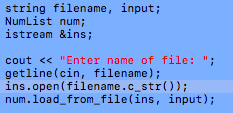

It with a file or string so that the stream knows where to get To input data you first need to create a stream and associate clog - like cerr, but its output is buffered.Stream is unit-buffered, which means that characters areįlushed after each block of characters is sent. cerr - the standard destination for error messages (often the terminal window).cout - the standard destination for output (often the terminal window).cin - the standard source of input (often the keyboard).Ios_base) and format/buffer control (via ios) The istream (input) features, state information (in So if the user used a ifstream to get input from a file, Istring ifstream iostream ofstream ostring The class hierarchy (inheritance tree) is as follows The Input section now if you want), but someĪwareness of this structure will help you understand the onlineĭocumentation and help you decide which include files to use. Usually users don't have to worry too much about this (skip to Tries to 'factor out' components that are needed in more than one class. True to form, C++ represents each distinct concept with a class, and The locales section has a example of using this feature. Which is usually set up appropriately by default. Vero? Such preferences are controlled by the locale, Should a bool value be printed out as true or The natural language required by the user has an influence on output.

state - Each stream has state information indicating whether.To control the behaviour of buffers, but often the default is ok. The character is written into a buffer, and whenĮnough characters are in the buffer to make updating worthwhile, theīuffer is flushed and the file on disc updated.
ISTREAM OPEN UPDATE
It would be inefficient to update a file on disc each time a character

Same set of commands whatever the nature of the source and destination. They can also flow into and out of strings. TheseĬharacters may be 1 byte or 2 byte ('wide'), the latter necessary for I/O uses the concept of streams - a flow of characters. I/O in more detail in an attempt to justify C++'s solution. Ifstream file("teste.Formatting, but also want high performance and ease of use.īefore we see how C++ attempts to reconsile these needs, let's consider Vector> data // Vetor que armazenará os dados do arquivo CSV
ISTREAM OPEN ARCHIVE
How I open my archive on this code (now it prints “Erro ao abrir o arquivo”)? #include If (!SPIFFS.begin(true /*FORMAT_SPIFFS_IF_FAILED*/))
ISTREAM OPEN SERIAL
If I use your platformio.ini and code #include ĭelay(1000) //give serial monitor time to connect See official examples and code for mount point. The same will apply if you start using a SD card. As per official examples and all tutorials out there, this is a prerequisite. However, the root of your problems seems that you do not call into the SPIFFS library at all to mount the SPIFFS partition in the filesystem. You’ve already corrected that in your first edit. The if statement in line 24 is also errornous: You’re creating the file2 variable but you’re checking file. I have to type out of all the text myself. First of all: Please do not post code as pictures.



 0 kommentar(er)
0 kommentar(er)
